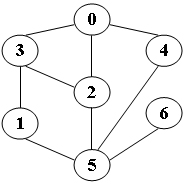函数接口定义:
void DFS( MGraph Graph, Vertex V, void (*Visit)(Vertex) );
其中MGraph是邻接矩阵存储的图,定义如下:
typedef struct GNode *PtrToGNode; struct GNode{ int Nv; /* 顶点数 */ int Ne; /* 边数 */ WeightType G[MaxVertexNum][MaxVertexNum]; /* 邻接矩阵 */ }; typedef PtrToGNode MGraph; /* 以邻接矩阵存储的图类型 */
函数DFS应从第V个顶点出发递归地深度优先遍历图Graph,遍历时用裁判定义的函数Visit访问每个顶点。当访问邻接点时,要求按序号递增的顺序。题目保证V是图中的合法顶点。
裁判测试程序样例:
#include <stdio.h> typedef enum {false, true} bool; #define MaxVertexNum 10 /* 最大顶点数设为10 */ #define INFINITY 65535 /* ∞设为双字节无符号整数的最大值65535*/ typedef int Vertex; /* 用顶点下标表示顶点,为整型 */ typedef int WeightType; /* 边的权值设为整型 */ typedef struct GNode *PtrToGNode; struct GNode{ int Nv; /* 顶点数 */ int Ne; /* 边数 */ WeightType G[MaxVertexNum][MaxVertexNum]; /* 邻接矩阵 */ }; typedef PtrToGNode MGraph; /* 以邻接矩阵存储的图类型 */ bool Visited[MaxVertexNum]; /* 顶点的访问标记 */ MGraph CreateGraph(); /* 创建图并且将Visited初始化为false;裁判实现,细节不表 */ void Visit( Vertex V ) { printf(" %d", V); } void DFS( MGraph Graph, Vertex V, void (*Visit)(Vertex) ); int main() { MGraph G; Vertex V; G = CreateGraph(); scanf("%d", &V); printf("DFS from %d:", V); DFS(G, V, Visit); return 0; } /* 你的代码将被嵌在这里 */
输入样例:给定图如下
5
输出样例:
DFS from 5: 5 1 3 0 2 4 6
代码:
void DFS( MGraph Graph, Vertex v, void (*Visit)(Vertex) ) { Visited[v]=true; Visit(v); for(int i=0; i<Graph->Nv; i++) { if(Graph->G[v][i]==1&&!Visited[i]) { DFS(Graph,i,Visit); } } }
简单的递归
需要注意的是题目代码中的这两句:bool Visited[MaxVertexNum]; /* 顶点的访问标记 */
MGraph CreateGraph(); /* 创建图并且将Visited初始化为false;裁判实现,细节不表 */
附测试点:

除此之外,来想一下MGraph CreatGraph里面究竟写了些什么
MGraph CreateGraph() { int Nv, i, VertexNum; int v1, v2; Vertex V, W ; MGraph Graph; scanf("%d", &VertexNum); Graph = (MGraph)malloc(sizeof(struct GNode)); Graph->Nv = VertexNum; Graph->Ne = 0; for(V = 0; V < Graph->Nv; V ++) { for(W = 0; W < Graph->Nv; W ++) { Graph->G[V][W] = INFINITY; } } scanf("%d", &Graph->Ne); if(Graph->Ne) { for(i = 0; i < Graph->Ne; i ++) { scanf("%d %d", &v1, &v2); Graph->G[v1][v2] = 1; Graph->G[v2][v1] = 1; } } return Graph; } void DFS( MGraph Graph, Vertex v, void (*Visit)(Vertex) ) { Visited[v]=true; Visit(v); for(int i=0; i<Graph->Nv; i++) { if(Graph->G[v][i]==1&&!Visited[i]) { DFS(Graph,i,Visit); } } }
https://blog.csdn.net/qq_42623428/article/details/83998955
int Nv, i, VertexNum; int v1, v2; Vertex V, W ;
变量设置,分别设置了顶点数目、之后循环用的变量(V和W)
MGraph Graph;
scanf("%d", &VertexNum); Graph = (MGraph)malloc(sizeof(struct GNode)); Graph->Nv = VertexNum; Graph->Ne = 0;
for(V = 0; V < Graph->Nv; V ++) { for(W = 0; W < Graph->Nv; W ++) { Graph->G[V][W] = INFINITY; } }
图的初始设置,建图申请空间,赋图的边数和点数;最后将所有权值赋极限
scanf("%d", &Graph->Ne); if(Graph->Ne) { for(i = 0; i < Graph->Ne; i ++) { scanf("%d %d", &v1, &v2); Graph->G[v1][v2] = 1; Graph->G[v2][v1] = 1; } }
输入内容,先输入边数,一条边对应两个顶点,以这两点为下标的数组赋1
